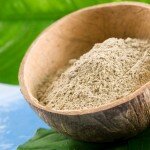A reminder of the exceptional benefits of papaya can help us include this power packed fruit into summer menus.
It’s hard to get excited about the look of ripe papaya’s mottled yellowish skin until you’ve tasted its delicious pulp. The impressive list of benefits encourages us to sample it, usually becoming fans for life.
All fruits are high in antioxidants, and with papaya’s rich orange colour we know it’s high in carotenes. Carotenoids are antioxidants and precursors to vitamin A, making them important for immune health and production of retinal for healthy skin and eyes, among many other functions.
Lycopene is another carotenoid in papaya, more strongly associated with tomatoes but with a good quantity in papaya. Lycopene’s antioxidant benefits include improvement for a number of diseased conditions linked to arterial health.
Papaya is also very high in vitamin C and flavonoids. These are crucial to many metabolic functions but well-known in relation to deficiency as a possible cause of frequent colds, easily bruising, frequent nose bleeds and excessive swelling after injury. One of the best known benefits of vitamin C is collagen synthesis, vital for skin and joint health. This fruit even contains a healthy dose of B vitamins that we know are necessary for good nerve health, including B6, B1 and folate or B9.
The proteolytic enzyme papain is an important part of papaya’s profile. Our body produces some proteolytic enzymes for protein breakdown, but some foods like papaya, are active health contributors to this function because of their high papain content.
Papain supplements are often used as a digestive aid, and some use it as a natural parasite cleanser because its traditional use includes dissolving tapeworms and other varieties. Both papaya leaves and papaya juice are reported as effective against some tropical diseases.
Papain’s other use today is to help relieve inflammatory conditions, including osteoarthris and muscle pain. Some studies have reported equal benefit to that of anti-inflammatory drugs for pain reduction! Both papaya’s papain enzyme and pineapple’s bromalain enzyme have been tested as effective in this regard.
One thing for sure is that you don’t want to miss sampling this incredible fruit when it’s in season. No point in waiting until you have a condition and need supplements, now is there.
http://www.ncbi.nlm.nih.gov/pubmed/23931131
Read how carotenoids are more bioavailable from papaya than from tomatoes or carrots in this above government study
http://www.ncbi.nlm.nih.gov/pubmed/12134711
Info on the role of carotenoids for health



 Click To Buy
Click To Buy